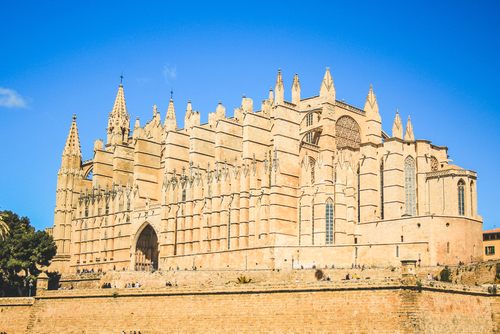 Château Sainte-Marie is a marvellous discovery. It is produced by the Dupuch Mondon Family in the up and coming Entre Deux Mers region and will impress the white wine appreciators amongst us. It’s an excellent wine with characteristics normally associated with more expensive bottles and at £6.49 this is a real find!
Château Sainte-Marie is a marvellous discovery. It is produced by the Dupuch Mondon Family in the up and coming Entre Deux Mers region and will impress the white wine appreciators amongst us. It’s an excellent wine with characteristics normally associated with more expensive bottles and at £6.49 this is a real find!
Château Sainte-Marie 2004 is a beautiful pale golden colour and is full of fragrance. With great aromas of lemon, lime and grapefruit with a hint of elderflower it is perfectly balanced on the palate offering a a well structured and long lasting finish.
It is made from 60% Sauvignon and 40% Semillon. Semillon grapes make up 80% of the blend in the most expensive and famous dessert wine in the world, Château d’Yquem and is one of the 3 grapes permitted to make white Bordeaux. The grape is a rich yellow colour that turns an amber pink as it ripens. The skin is thin and tender so the grape can actually get sunburnt!
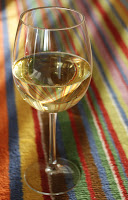 Château Sainte-Marie makes an excellent aperitif served nicely chilled as it is less dry than most but is superb with cheeses like Roquefort, Asparagus and Avocado. Summer salads of Rocket, Balsamic vinegar, laced with nuts spring to mind as it will pair well with these.
Château Sainte-Marie makes an excellent aperitif served nicely chilled as it is less dry than most but is superb with cheeses like Roquefort, Asparagus and Avocado. Summer salads of Rocket, Balsamic vinegar, laced with nuts spring to mind as it will pair well with these.
However the best food to match Château Sainte-Marie with are Oysters and Shellfish. Arachon Oysters from the Arachon Basin in Bordeaux have been enjoyed by the French – and British! – since Roman times.
In the 4th century the Latin poet Ausonius– who was born in Bordeaux – sent la Gravette, the flat Arachon Oyster, to the Emperor Gratianus with the inscription “a humble rock that reveals flesh swimming in a sweet and delicate juice”.
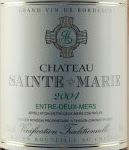 Oyster parks were started in France by Napoleon 3rd, because the gathering of wild oysters was wiping the species out. The first farm started work in the Arcachon area, in 1849. The oyster farmers are known locally as paysans de la mer and they spend hours raking the land at low tide, cleaning the beds and checking the rope yarns or grills that keep out predators.
Oyster parks were started in France by Napoleon 3rd, because the gathering of wild oysters was wiping the species out. The first farm started work in the Arcachon area, in 1849. The oyster farmers are known locally as paysans de la mer and they spend hours raking the land at low tide, cleaning the beds and checking the rope yarns or grills that keep out predators.
Fans of the Arcachon oyster maintain that it has a much more refined and delicate taste and texture than the faster-growing but colder Normandy oyster. But even within the Arcachon Basin, flavours and aromas vary from ‘forest-like’ tastes of mushrooms, which can be detected in oysters which grow near to the mouth of the river La Leyre, to fruit, vegetable and citrus notes in oysters that have come from further out in the bay.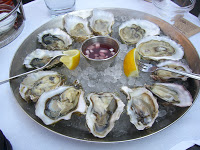
Huîtes Crues (Raw Oysters)
24 Oysters in their shells
1 shallot finely chopped
2 tbsp red wine vinegar
1 lemon cut in wedges
Carefully open the oysters. Loosen the oyster from the bottom shell being careful not to lose any liquid. Nestle the oysters on a large bed of crushed ice or rock salt. Mix the shallot with the red wine vinegar and some black pepper and pour into a small bowl. Put the bowl in the centre of the platter, surround the oysters with the lemon wedges and serve with slices of brown or rye bread and butter.
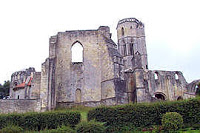 The renown of Château Sainte-Marie goes back several centuries, as the vineyard belonged to the 12th century Benedictine Abbaye de la Sauve Majeure (one of the most ancient abbeys in France, located just 4 km from the château).
The renown of Château Sainte-Marie goes back several centuries, as the vineyard belonged to the 12th century Benedictine Abbaye de la Sauve Majeure (one of the most ancient abbeys in France, located just 4 km from the château).
The Abbey takes its name from the Silva Major – the great forest that then occupied the whole region known as Vignoble de l’Entre Deux Mers (vineyard between the two seas) which was given as a gift by Duke William VIII of Aquitaine. In fact Eleanor of Aquitaine, famous for introducing claret to England with her husband Henry II, often stayed there.
Pilgrims often stopped at the Abbey on route to Saint-Jacques-of-Compostelle and legend says that miracles happened as the blind were healed and could then see.
 Much of the Château was devastated by fire and only the giant 400 year old sequoias remain. The Dupuch Family have been making wine at Château Sainte-Marie since 1956 with fierce commitment, talent and a great attachment to the originality of the terroir.
Much of the Château was devastated by fire and only the giant 400 year old sequoias remain. The Dupuch Family have been making wine at Château Sainte-Marie since 1956 with fierce commitment, talent and a great attachment to the originality of the terroir.
The south facing vineyards are set right in the middle of Entre Deux Mers, only 25 km from Bordeaux.  The vines stretch over 2 sunny hilltops which are amongst the highest points in the Gironde and resemble 2 small islands standing proud in a sea of green.
The vines stretch over 2 sunny hilltops which are amongst the highest points in the Gironde and resemble 2 small islands standing proud in a sea of green.
Old vines with low yields, including a 100 year-old parcel of Semillon and Merlot, guarantee a top quality production.
The Dupuch Family follow ancestral practices and operate a mode of respectful culture of the environment for a clean and durable agriculture. Some of their wines are made from small islands of vineyards grown at various communes around the estate.
Each parcel of vines are grown particularly to suit the soil which is primarily clay/limestone and gravel. Each little vineyard has a name: “Old Vines” (near Holy Marie in the village of Targon), “Pierre Creusée” (near Capian) and “the Mill” (with its panoramic view across Entre Deux Mers). The average age of the vines is 25 years old and the grapes are carefully gathered by hand.
As the Dupuch’s say:
“Red or white, the wine is a history of time. Time in the making, time in the harvesting, time of fermenting, macerating, draining, bâtonnage, breeding. Patience must be the one principal virtue of the vine grower.”
I would add a phrase – “and time in the drinking” as Château Sainte-Marie is a wine to be savoured!
Images Courtesy of www.flickr.com

